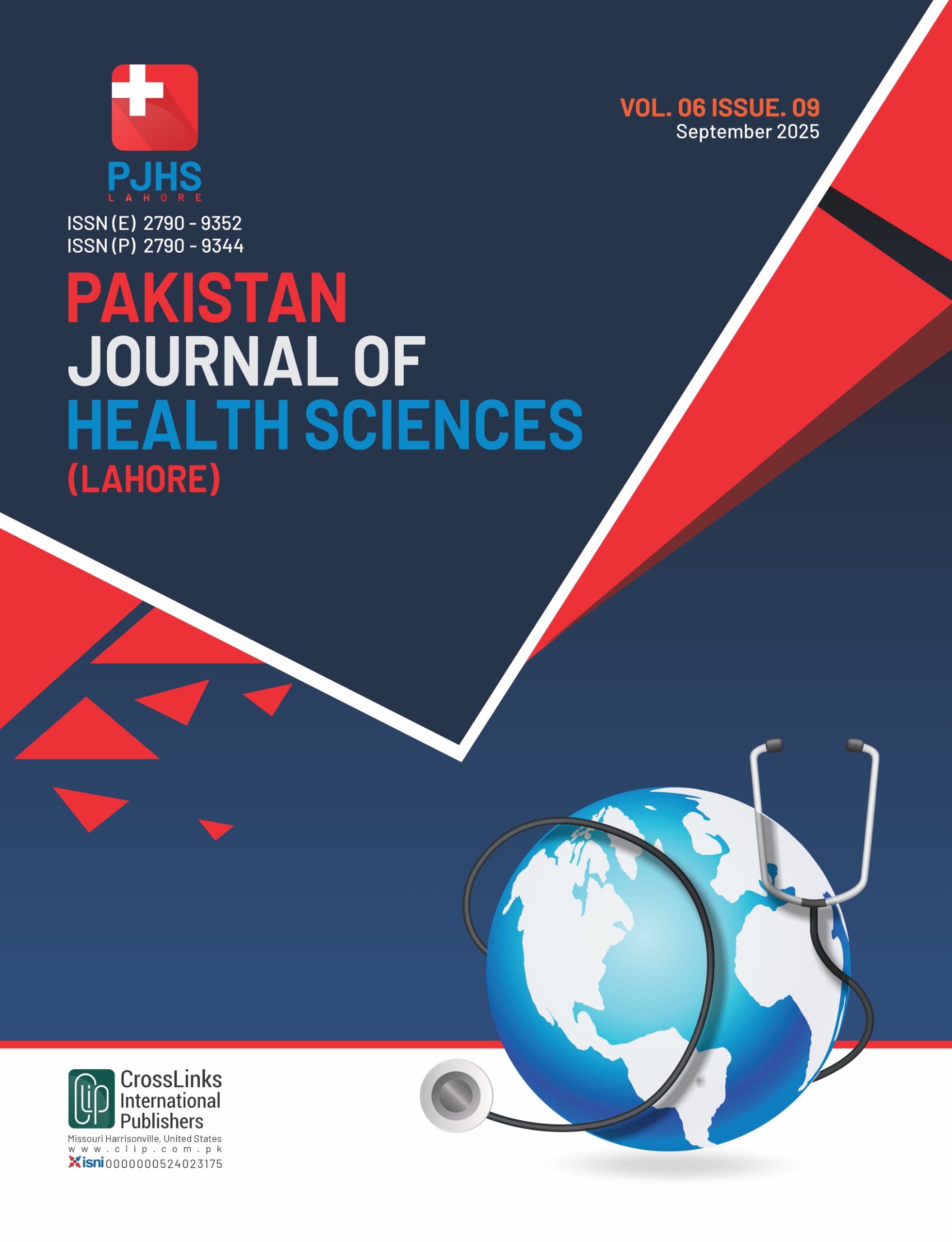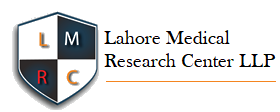Alveolar Bone Dimensions in Orthodontic Unilateral Impacted Canine Cases using Cone Beam Computed Tomography
Orthodontic Unilateral Impacted Canine Cases using CBCT
DOI:
https://doi.org/10.54393/pjhs.v6i9.3001Keywords:
Alveolar Bone, Orthodontic, Cone Beam Computed Tomography Imaging, ImpactionAbstract
Impacted canines are due to missing laterals, crowding, or genetics. The alveolar bone that acts as a shock absorber distributes the masticatory forces to the underlying tissues. Objectives: To study the mean alveolar bone dimensions on the impaction and non-impaction side of Orthodontic unilateral impacted canine cases using CBCT. Methods: This descriptive cross-sectional research was organized at the Department of Orthodontics, CMH Lahore Medical College, where 165 patients were enrolled as per the selection criteria. Bucco-palatal width of the alveolar bone was measured at the level of the alveolar crest, while alveolar bone height was calculated from the alveolar crest to the nasal floor, on the impacted side. These were compared with corresponding alveolar bone dimensions on the non-impaction side, and the values were recorded. An independent samples t-test was used to find out whether any significant difference was present, and post-stratification. A p-value<0.05 was considered significant. Results: The mean age of the patients was 34.99 ± 14.69 years. There were 77 (46.7%) male and 88 (53.3%) female. On the impacted side, the mean width of alveolar bone was 6.58 ± 0.67 mm, and the mean height was 17.28 ± 0.67 mm. On the non-impacted side, the mean width and height of alveolar bone were 8.40 ± 0.96 mm and 19.01 ± 0.96 mm, respectively (p=0.001). Conclusions: The mean width and height of the alveolar bone on the impacted canine side were lower than the respective alveolar bone dimensions on the non-impacted side.
References
Momeni Danaie S, Salehi P, Kalantary MH. The Importance of Maxillary Canine: A Review. Journal of Dentistry. 2019 Jan; 4(3): 53-61.
Kiran S, Nazir A, Khaliq F, Zahid Mr, Fayyaz A, Alishbah A. Frequency, Causes and Pattern of Presentation of Impacted Maxillary Canine, A Clinical and Radiographic Study. Pakistan Journal of Medical and Health Sciences. 2023; 17(11): 65-. doi: 10.53350/pjmhs02023171165. DOI: https://doi.org/10.53350/pjmhs02023171165
Firincioglulari M, Kurt D, Koral S, Orhan K. Maxillary Canine Impaction: Assessing the Influence of Maxillary Anatomy Using Cone Beam Computed Tomography. Medical Science Monitor: International Medical Journal of Experimental and Clinical Research. 2024 May; 30: e944306-1. doi: 10.12659/MSM.944306. DOI: https://doi.org/10.12659/MSM.944306
Papageorgiou SN, Seehra J, Cobourne MT, Kanavakis G. Does Current Evidence Support the Discussion Around the Guidance Theory? A Systematic Review and Meta‐Analysis on the Association Between Maxillary Lateral Incisor Agenesis and Displacement or Impaction of the Permanent Canine. Orthodontics and Craniofacial Research. 2025 Apr; 28(2): 312-23. doi: 10.1111/ocr.12878. DOI: https://doi.org/10.1111/ocr.12878
Sathyanarayana HP, Nucci L, d’Apuzzo F, Perillo L, Padmanabhan S, Grassia V. Prevalence, Etiology, Clinical Features and Management Associated with Impacted and Transmigrated Mandibular Canines: A Systematic Review. BioMed Central Oral Health. 2023 Dec; 23(1): 975. doi: 10.1186/s12903-023-03717-1. DOI: https://doi.org/10.1186/s12903-023-03717-1
Sharhan HM, Almashraqi AA, Al-Fakeh H, Alhashimi N, Abdulghani EA, Chen W et al. Qualitative and Quantitative Three-Dimensional Evaluation of Maxillary Basal and Dentoalveolar Dimensions in Patients with and without Maxillary Impacted Canines. Progress in Orthodontics. 2022 Oct; 23(1): 38. doi: 10.1186/s40510-022-00434-3. DOI: https://doi.org/10.1186/s40510-022-00434-3
Sadrhaghighi AH, Farrokhi S, Rad M, Eskandarinezhad M. Evaluation of the Association of Alveolar Bone Dimensions in Unilateral Palatally Impacted Canine: A Cone-Beam Computed Tomography Analysis. Journal of Orofacial Sciences. 2022 Jan; 14(1): 21-7. doi: 10.4103/jofs.jofs_79_22. DOI: https://doi.org/10.4103/jofs.jofs_79_22
Tadinada A, Mahdian M, Vishwanath M, Allareddy V, Upadhyay M, Yadav S. Evaluation of Alveolar Bone Dimensions in Unilateral Palatally Impacted Canine: A Cone-Beam Computed Tomographic Analyses. European Journal of Orthodontics. 2015 Feb; 37(6): 596-602. doi: 10.1093/ejo/cju098. DOI: https://doi.org/10.1093/ejo/cju098
Karnati PK, Seth P, Zamzuri AT, Tharwani P. Orthodontically Induced External Apical Root Resorption in Class II Malocclusion. Case Reports in Dentistry. 2021; 2021(1): 8290429. doi: 10.1155/2021/8290429. DOI: https://doi.org/10.1155/2021/8290429
Peralta-Mamani M, Rubira CM, López López J, Honório HM, Rubira-Bullen IR. CBCT vs Panoramic Radiography in Assessment of Impacted Upper Canine and Root Resorption of the Adjacent Teeth: A Systematic Review and Meta-Analysis. Journal of Clinical and Experimental Dentistry. 2024 Jan; 16(2): 198-222. doi: 10.4317/jced.61285. DOI: https://doi.org/10.4317/jced.61285
Yassaei S, Safi Y, Valian F, Mohammadi A. Evaluation of Maxillary Arch Width and Palatal Volume and Depth in Patients with Maxillary Impacted Canine by CBCT. Heliyon. 2022 Oct; 8(10). doi: 10.1016/j.heliyon.2022.e10854. DOI: https://doi.org/10.1016/j.heliyon.2022.e10854
Alhummayani FM and Mustafa ZA. A New Guide Using CBCT to Identify the Severity of Maxillary Canine Impaction and Predict the Best Method of Intervention. Journal of Orthodontic Science. 2021 Jan; 10(1): 3. doi: 10.4103/jos.JOS_41_20. DOI: https://doi.org/10.4103/jos.JOS_41_20
Grybienė V, Juozėnaitė D, Kubiliūtė K. Diagnostic Methods and Treatment Strategies of Impacted Maxillary Canines: A Literature Review. Stomatologija. 2019 Jan; 21(1): 3-12.
Gudelevičiūtė I, Spaičytė N, Smailienė D. Skeletal and Dental Maxillary Morphological Characteristics in Patients with Impacted Canines: Systematic Review and Meta-Analysis. European Journal of Orthodontics. 2023 Dec; 45(6): 832-41. doi: 10.1093/ejo/cjad050. DOI: https://doi.org/10.1093/ejo/cjad050
Dinu Ş, Todor L, Zetu IN, Păcurar M, Porumb A, Milutinovici RA et al. Radiographic Methods for Locating Impacted Maxillary Canines. Romanian Journal of Morphology and Embryology. 2022 Dec; 63(4): 599.
Mucedero M, Rozzi M, Di Fusco G, Danesi C, Cozza P. Morphometric Analysis of the Palatal Shape and Arch Dimension in Subjects with Buccally Displaced Canine. European Journal of Orthodontics. 2020 Oct; 42(5): 544-50. doi: 10.1093/ejo/cjz091. DOI: https://doi.org/10.1093/ejo/cjz091
Elhamshary SA, Refaat WE, Ramadan AA. Maxillary Transverse Dimensions in Subjects with Impacted Canine Compared with Normal Subjects Using Cone Beam Computed Tomography. Dental Science Updates. 2023 Mar; 4(1): 141-7. doi: 10.21608/dsu.2023.148976.1132. DOI: https://doi.org/10.21608/dsu.2023.148976.1132
Sar S, Singh M, Sharma A, Sharma P, Raza M. Skeletal and Dentoalveolar Dimensions in Unilateral Impacted Canınes, A Cone Beam Computed Tomography Study. European Oral Research. 2022 May; 56(2): 74-9.
Montes-Díaz ME, Martínez-González A, Arriazu-Navarro R, Alvarado-Lorenzo A, Gallardo-López NE, Ortega-Aranegui R. Skeletal and Dental Morphological Characteristics of the Maxillary in Patients with Impacted Canines Using Cone Beam Computed Tomography: A Retrospective Clinical Study. Journal of Personalized Medicine. 2022 Jan; 12(1): 96. doi: 10.3390/jpm12010096. DOI: https://doi.org/10.3390/jpm12010096
Arvind TP, Jain RK, Nagi R, Tiwari A. Evaluation of Alveolar Bone Microstructure Around Impacted Maxillary Canines Using Fractal Analysis in Dravidian Population: A Retrospective CBCT Study. The Journal of Contemporary Dental Practice. 2022 Sep; 23(6): 593-600. doi: 10.5005/jp-journals-10024-3343. DOI: https://doi.org/10.5005/jp-journals-10024-3343
Downloads
Published
How to Cite
Issue
Section
License
Copyright (c) 2025 Pakistan Journal of Health Sciences

This work is licensed under a Creative Commons Attribution 4.0 International License.
This is an open-access journal and all the published articles / items are distributed under the terms of the Creative Commons Attribution License, which permits unrestricted use, distribution, and reproduction in any medium, provided the original author and source are credited. For comments













